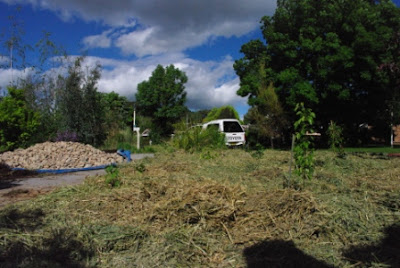I have been less mobile over the last month while my leg injury heals and have been a little slacker in chasing down local fruit and vegies supplies and own garden is now only just waking after the Orange winter.
I used the opportunity to just see just where my fruit and vegies in one shop came from.... it is only a calculation from farm (or closest guesstimate for some produce) to our house in a direct line - so does not include getting transported to market, then a warehouse before getting out to our local store.
So here is my list from earlier in the week (just from the fresh food shop)-
Tomatoes (NZ - 2200 km)
Kiwi fruit (NZ - 2200 km)
Bananas (Mackay QLD - 1350 km)
Free range pork (near Geelong Vic - 715 km)
Oranges (Griffith NSW - 305 km)
Pink Lady Apples (WA - 3050 km)
Asparagus (Koo Wee Rup, Vic - 650 km)
Mushrooms (Sydney, NSW - 163 km)
Mini Roma Tomatoes (Coldstream Vic - 590 km)
Red Capsicum (QLD - 800 km)
Zucchinis (Vic - 600 km)
Broccoli (Vic - 600 km)
Pineapple (QLD - 800 km)
Avocados (WA - 3050 km)
Beans (Kalbar QLD - 710 km)
Garlic (China - 9000 km)
Mangoes (Darwin NT - 3000 km)
All in all - the average distance fresh food came from (as the crow flies) was 1752 km!!! Staggering I thought - considering it was likely to be a huge underestimate of actual miles / kilometres.
That was inspiration enough for me to work harder at sourcing local produce. Here is our "100 mile diet" area.
For more general discussions on Food Miles check these links out -
An article about where it all started....
The 100-mile Diet
Choice has put together a great article on the distance food travels to get to use -
Food Miles - Why eat local?
CERES in Melbourne have also put out a
great report on food miles, including the green house gas emissions - here is an extract -
"Data was collected to establish food miles and greenhouse gas emissions estimates for a typical food basket in Victoria. The total distance of the road transportation in the food basket was estimated at 21,073 kilometres (km), almost the same distance to travel around Australia’s coastline (25,760 km). The total distance for all transportation of the food basket was estimated at 70,803 km, equivalent to travelling nearly twice around the circumference of the Earth (40,072 km), or travelling around Australia's coastline three times.
The total greenhouse gas emissions estimate for all food trucks transporting all road-transported food items, over the total road transport distance, was 11, 327 tonnes (t) CO2–e. If all the food trucks were transporting all food items on the same day, the emissions from this one day of transportation (11, 327 t CO2–e), is equivalent to 2, 832 cars driving for one year."
Check out the full report
here.
OUR COMMITMENT
We as a family will be looking more closely at all the food we purchase and will will be using these simple ideas for reducing our food miles...
- Grow our own food where possible (being our third year in Orange our home garden is now starting to be productive)
- Become more active members of the community garden at the ELF (Environmental Learning Facility) in Orange - the Orange Farmers Markets are nearby on the same morning (second Saturday of the month)
- As a first stop - shop at local shops or directly from the wonderful orchards in the Orange area
- Eat fruit and vegies that are in season - don't get cherries from the USA in mid winter because you can.
What do you do to reduce your food miles?
Have you ever worked out the food miles of the food you buy from shops?






















